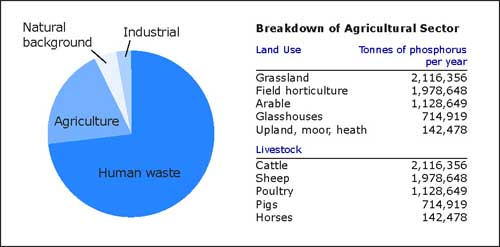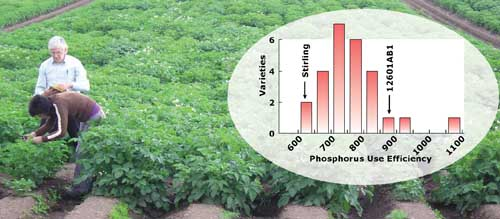Sustainable Approaches To Crop Mineral Nutrition
Published on 1 September 2009 in Sustainability and Communities
Introduction
Edible crops ultimately provide most of the carbohydrates and essential vitamins and minerals for humankind. Crop production must, therefore, keep pace with human populations to avoid global starvation, and crop quality must be maintained to avoid malnutrition. Both crop production and the quality of produce are intimately linked to the mineral nutrition of the plant.
In addition to oxygen, carbon-dioxide and sunlight, all plants require clean water and at least fourteen mineral elements. Six mineral elements, nitrogen (N), phosphorus (P), potassium (K), calcium (Ca), magnesium (Mg), and sulphur (S), are required in large amounts. These are termed ‘macronutrients’ and are generally supplied as inorganic fertilisers, mineral rocks or organic manures to maximise crop production. Other mineral elements must also be supplied to crops if they are lacking in the soil. These include the ‘micronutrients’ boron (B), iron (Fe), manganese (Mn), zinc (Zn), copper (Cu), nickel (Ni), molybdenum (Mo) and chlorine (Cl).
The first Green Revolution, which has enabled the burgeoning human population to be fed until now, was founded on the development of crop varieties whose yields could be increased by the application of mineral fertilisers in conjunction with effective herbicides and pesticides. Fundamental to this strategy was the synthesis of N-fertilisers from nitrogen in the air using the energy-driven Haber-Bosch process and the patented production of P-fertilisers from rock phosphates using sulphuric acid.
Considerable gains in crop yields and quality have been achieved in world agriculture using fertilisers, but at the expense of finite natural resources, such as fossil fuels and mineral rocks, the production of greenhouse gasses (GHG) in the manufacture and transport of inorganic fertilisers, and the loss of mineral elements to the natural environment, leading to the processes of eutrophication.
Whilst maintaining crop yield and quality must remain our goal, a second Green Revolution must strive to achieve these goals in a more sustainable manner. This will involve using alternative sources, and effective recycling, of mineral elements for agricultural production and the development of crops that yield well with reduced fertiliser inputs.

Figure 1: Contributions from different sources to the phosphorus load of British waters. Data taken from P.J. White & J.P. Hammond (2006) Updating the estimate of the sources of phosphorus in UK waters. Defra project W10701CSF.
Key Points
- Plants require fourteen essential mineral elements. Unless these are already available in sufficient quantities in the soil, they must be supplied to crop plants to optimise their yield and quality.
- Six mineral elements are required by plants in large quantities and are commonly applied in fertilisers. These are nitrogen (N), phosphorus (P), potassium (K), calcium (Ca), magnesium (Mg), and sulphur (S).
- The synthesis of N-fertilisers consumes energy and contributes significantly to the production of greenhouse gasses, losses of N and P from agricultural land contribute to the processes of eutrophication, and it has been estimated that commercially viable sources of P and S will be exhausted within 50 years.
- To sustain crop production in the future, alternative sources, and effective recycling, of mineral elements for agricultural production will be necessary and varieties of crops that yield well with reduced fertiliser inputs must be sought.
Research Undertaken
The objective of much current research on the mineral nutrition of crop plants is to develop strategies to maintain yields and quality whilst reducing fertiliser inputs. This research will lead to greater environmental and economic sustainability. Reduced fertiliser inputs can be achieved through two complimentary strategies: agronomic innovation and plant breeding.
Farm-management plans, based soil testing and the use of fertiliser recommendation systems, aim to optimise crop yields by matching fertiliser applications to plant demands. Research at SCRI is contributing to the development of fertiliser recommendation systems, not only by quantifying yield responses to the application of fertilisers but also through the development of software packages, such as the Management Advisory Package for Potatoes (MAPP), based on computer models of plant growth.
Precision farming methods also offer opportunities to reduce fertiliser applications. Practical methods to target the application of fertilisers to specific areas of a field, using GIS and green-seeker technology, or to the rooting zone of crops, either by injection of liquid fertilisers or placement of solid fertilisers, are being studied. These techniques are particularly effective with wide-row crops, such as potatoes and field vegetables, and recent results suggest that the placement of P-fertilisers might halve P-inputs without adversely affecting crop yield or quality.

Figure 2: Aerial photograph of a field experimental site at SCRI where the effects of compost and slurry amendments to soil are being investigated. SCRI Annual Report 2008.
In the past, gains in agricultural production have been achieved by consuming finite natural resources. By definition, this is unsustainable. We are, therefore, developing methods to supplement, or replace, inorganic fertilisers with alternative fertilisers, such as composts from urban green wastes, animal manures, and struvite (an abundant ammonium magnesium phosphate reclaimed from sewage). We have observed that quality composts made from urban green wastes (the cuttings, clippings and weeds from gardens and public spaces) can restore some of the C and N lost from soils and improve their structure, water retention and workability. When used as supplementary fertilisers, these amendments can increase yields and improve product quality. Similarly, field trials have demonstrated that struvite is an effective P-fertiliser for various crops, although further work must be undertaken before it can be recommended for arable agriculture. Theoretically, if all the P in sewage were recovered as struvite in Britain, this compound could supply up to 40% of the nation’s demand for P-fertiliser.
Maintaining soil quality is fundamental to the efficient use of fertilisers. The soil is the substance in which plants grow, retains the water necessary for life, and contains the carbon to sustain the activities of the micro-organisms that underpin the cycling of essential elements in the ecosystem. For these reasons, we are investigating how soils can be managed to achieve sustainable crop production with reduced fertiliser inputs. A new experimental platform at Balruddery Farm, near Dundee, has been established to implement sustainable management practices that promise to maintain soil quality and crop yields with reduced mineral inputs, GHG emissions, and mineral losses to the environment.

Figure 3: Screening potato varieties in the field for their ability to acquire and utilise P-fertilisers. Tim George and colleagues (2007) Phosphorus efficient potatoes. SCRI Annual Report 2007.
Research at SCRI also seeks to identify the genetic basis of physiological traits that enable plants to acquire and utilise mineral elements more efficiently in order to breed crops that require less fertiliser. These traits include: root systems optimised for mining the soil, lower tissue requirements for mineral elements, and greater partitioning of biomass to the harvested portion in reduced-input systems. Our major focus is on important cereal, brassica and potato crops. There is significant genetic variation within all these crops in the physiological traits that determine mineral acquisition and utilisation within the plant, providing sufficient potential to breed new varieties that require less fertiliser.
Policy Implications
The need to reduce mineral inputs, GHG emissions, and losses of mineral elements to the environment is implicit in many recent policy documents. These policy documents allow compliance with current national and international legislation. For example:
The Scottish Government aims to halve GHG emissions by 2030. Since agriculture produces a significant proportion of Scottish GHG, and the production, transport and use of N-fertilisers contributes most to GHG emissions from the arable sector, the Scottish Government is investigating ways to reduce GHG emissions from these sources.
The EU Water Framework Directive requires surface and coastal waters to reach a good chemical and ecological status by 2015. The adoption of Best Management Practices, as described by SEPA and Defra , that include fertiliser-management plans will help to achieve this target.
In accordance with the EU Nitrates Directive, the Scottish Government has designated a number of Nitrate Vulnerable Zones (NVZs), in which the application of N-fertilisers is subject to strict regulation, to reduce water pollution by nitrates.
The updating of recommendations for the timing and amounts of fertilisers used on crops, such as those contained in Defra’s RB209 ‘Fertiliser Recommendations for Agricultural and Horticultural Crops’ will be instrumental in regulating future fertiliser inputs and their consequences for the environment.
Author
Professor Philip J. White, Leader of the Environment Plant Interactions Programme, SCRI Philip.White@scri.ac.uk
Topics
Sustainability and Communities
Comments or Questions
Related External Documents
- A Greener Scotland
- Scottish Government GHG Str...
- EU Water Framework Directive
- Nitrate Vulnerable Zones
- SEPA







